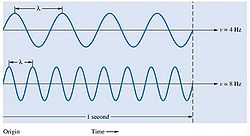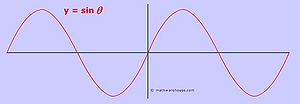Wavelength: Difference between revisions
Okaykeeseok (talk | contribs) |
Okaykeeseok (talk | contribs) |
||
| Line 6: | Line 6: | ||
[[File:Wiki_00000.jpg|left|250px]] | [[File:Wiki_00000.jpg|left|250px]] | ||
Wavelength depends on the medium that a wave travels through, such as air, vacuum, and water. Wavelength is a measure of the distance between repetitions of a shape feature such as peaks, valleys, or zero-crossings, not a measure of how far any given particle moves. | Wavelength depends on the medium that a wave travels through, such as air, vacuum, and water. Wavelength is a measure of the distance between repetitions of a shape feature such as peaks, valleys, or zero-crossings, not a measure of how far any given particle moves. | ||
Revision as of 21:10, 1 March 2016
Wavelength

In physics, wavelength is the distance in which wave's shape repeats. Wavelength is usually determined by measuring the distance between repeating patterns. Wavelength is commonly designated by the Greek letter, lambda (λ), and the SI unit of wavelength is nanometers(nm). Different length in wave cause different colors to be reflected. The concept can also be applied to periodic waves of non-sinusoidal shape. Sinusoidal shapes are the shapes of cosine and sine graphs. The term wavelength is also sometimes applied to modulated waves, which are the waves transmitted when information is conveyed. If a sinusoidal wave moving at a constant speed, wavelength is inversely proportional to frequency of the wave: waves with higher frequencies have shorter wavelengths, and lower frequencies have longer wavelengths. The formula for frequency and wavelength is v=fλ.

Wavelength depends on the medium that a wave travels through, such as air, vacuum, and water. Wavelength is a measure of the distance between repetitions of a shape feature such as peaks, valleys, or zero-crossings, not a measure of how far any given particle moves.
A Mathematical Model
We can easily determine wavelength for sinusoidal shaped graphs. For sin(θ), the wavelength would be 2π, since the wave repeats itself every 2π. For sine graph, the wavelength is determined by using the formula, 2π/x, where sin(xθ).

A Computational Model
In this case when we are observing the forces applied to a spring moving up and down, we can measure how force repeats by seeing the wavelength of the graph. [1]
Examples
Simple
Since frequency and wavelength are closely related, wavelength can be found if frequency is given. In the question below, λν = c. Since the speed of light and frequency is given, wavelength could be easily determined by plugging in the numbers.
Middling
A harmonic wave is traveling along a rope. The source generating the waves completes 50 to and fro motions in 25 s. A trough travels 2m in 4s. calculate the wavelength of the wave?
Solution:
Time taken for 50 oscillations = 25 s
Time for 1 oscillation, t = 25/50 = 0.5 s
Frequency of 1 oscillation, f = 1/0.5 = 2 Hz
The wave travels a distance of 2m in 4s. The wave speed is given by v = 2/4 = 0.5 ms-1
The wavelength is given by λ = v/f, λ=.5/2=.25
Connectedness
How is this topic connected to something that you are interested in?
This topic is not something what I am interested in, but I am willing to have interest from now on. While researching for wiki resource, I learned that different types are waves are deeply related to my current life. I would like to especially learn about the sound waves.
How is it connected to your major
I do not know how this will be connected to my major since I do not know anything about my major. Since concept of wavelength is used in diverse fields, I think this would be related to my major.
Is there an interesting industrial application?
There are interesting industrial application of waves. From radio to ultrasounds, waves are applied through industry.
History

The concept of wavelength was first discovered by Isaac Newton. Many people were using prism to experiment with color before Newton’s famous experiments with light. When Newton was observing prism below sunlight, he saw different colors being emitted on the other side of the prism. Newton then realized that you need to move the screen far away in order to get a proper spectrum. After moving the screen and achieving a beautiful spectrum he conducted an experiment to prove that the prism was not colouring the light. He put a screen in the way of his spectrum, and this screen had a slit cut in it, and only let the green light go through. Newton built the first practical reflecting telescope and developed a theory of colour based on the observation that a prism decomposes white light into the many colours of the visible spectrum, and he also studied the speed of sound.
See also
